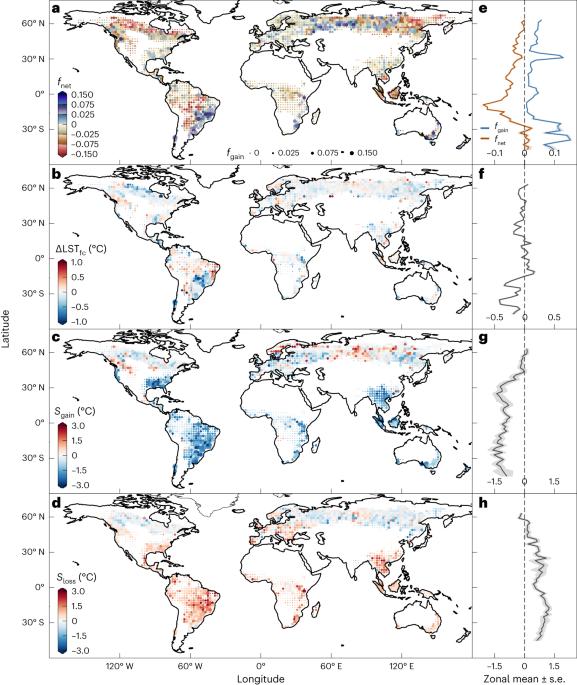森林覆盖增减对地表温度的不对称影响
IF 29.6
1区 地球科学
Q1 ENVIRONMENTAL SCIENCES
引用次数: 1
摘要
人们对细尺度树木覆盖变化对气温的直接生物物理影响还不甚了解。在这里,我们展示了地表温度是如何对亚网格树木总覆盖率变化做出反应的。我们发现,在许多森林中,树木植被增加导致的蒸散作用增强所引起的生物物理降温幅度要大于树木植被减少所引起的升温幅度。因此,要实现树木植被变化不产生生物物理升温效应的目标,就必须恢复以前损失的部分树木植被面积。这一比例在不同的森林生物群落中有所不同,从热带森林的 75% 到温带森林的 83% 不等。忽略细尺度树木覆盖变化的这种非对称温度效应忽略了一个事实,即即使在净零树木覆盖变化的情况下,生物物理反馈也会继续导致地表温度变化。因此,在量化森林的生物物理效应时,有必要考虑树木覆盖的总变化,而不是净变化。树木覆盖率的变化会以多种方式改变地表温度。在这里,作者展示了树木覆盖率变化的非对称直接生物物理效应,因为在大多数森林中,树木覆盖率增加带来的降温幅度要大于树木覆盖率减少带来的升温幅度。本文章由计算机程序翻译,如有差异,请以英文原文为准。

Asymmetric influence of forest cover gain and loss on land surface temperature
The direct biophysical effects of fine-scale tree cover changes on temperature are not well understood. Here, we show how land surface temperature responds to subgrid gross tree cover changes. We find that in many forests, the biophysical cooling induced by enhanced evapotranspiration due to tree cover gain is greater in magnitude than the warming from tree cover loss. Therefore, the goal of no biophysical warming effects from tree cover changes could be achieved by regaining a fraction of previously lost tree cover areas. This percentage differs between different forest biomes, ranging from 75% in tropical to 83% in temperate forests. Neglecting this asymmetric temperature effect of fine-scale tree cover change ignores the fact that biophysical feedbacks continue to cause surface temperature changes even under net-zero tree cover changes. Thus, it is necessary to account for gross, rather than net, tree cover changes when quantifying the biophysical effects of forests. Changes in tree cover can change surface temperatures in multiple ways. Here, the authors show an asymmetric direct biophysical effect of tree cover change, as the cooling due to tree cover gain is greater in magnitude than the warming from tree cover loss in most forests.
求助全文
通过发布文献求助,成功后即可免费获取论文全文。
去求助
来源期刊

Nature Climate Change
ENVIRONMENTAL SCIENCES-METEOROLOGY & ATMOSPHERIC SCIENCES
CiteScore
40.30
自引率
1.60%
发文量
267
审稿时长
4-8 weeks
期刊介绍:
Nature Climate Change is dedicated to addressing the scientific challenge of understanding Earth's changing climate and its societal implications. As a monthly journal, it publishes significant and cutting-edge research on the nature, causes, and impacts of global climate change, as well as its implications for the economy, policy, and the world at large.
The journal publishes original research spanning the natural and social sciences, synthesizing interdisciplinary research to provide a comprehensive understanding of climate change. It upholds the high standards set by all Nature-branded journals, ensuring top-tier original research through a fair and rigorous review process, broad readership access, high standards of copy editing and production, rapid publication, and independence from academic societies and other vested interests.
Nature Climate Change serves as a platform for discussion among experts, publishing opinion, analysis, and review articles. It also features Research Highlights to highlight important developments in the field and original reporting from renowned science journalists in the form of feature articles.
Topics covered in the journal include adaptation, atmospheric science, ecology, economics, energy, impacts and vulnerability, mitigation, oceanography, policy, sociology, and sustainability, among others.
 求助内容:
求助内容: 应助结果提醒方式:
应助结果提醒方式:


